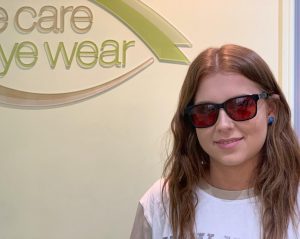
Should I have tinted lenses?
For overly 200 years there have been claims that coloured filters in the form tinted spectacle lenses or transparent coloured overlays can aid with reading performance and cure dyslexia. These claims remain highly controversial with publications making such claims having been generally criticized for lacking traditional scientific research methods and analysis.
In the early 1980’s a New Zealand teacher by the name of Olive Meares and an American psychologist by the name of Helen Irlen working independently documented improvements in reading abilities using coloured overlays. This problem was later termed Meares-Irlen or Scoptic Sensitivity Syndrome.
Subsequently the findings of more recent randomized controlled trials have been highly critically of the approach used by Irlen method diagnosticians. One recent study suggestion no immediate effect on reading in children with reading difficulties and high rates with coloured overlays. [1]
A recent systematic review of this topic from studies who have adopted methods consistent with scientific literature has provided some key findings
- The first finding is that coloured filters can alleviate symptoms and improve performance in people who suffer from visual stress.
Visual stress, sometimes known as pattern glare, is a symptom based diagnoses characterized by visual perceptual distortions, headaches and eye strain that can be induced by looking at patterns such a print on a page. The proposed mechanism is that the repetitive stimulation creates hyper excitability of the visual cortex and altering the spectral composition of the retinal image reduces this type of brain stimulation.
- Only a minor subset of patients classified with dyslexia, estimated at 20%, have symptom consistent with visual stress or pattern glare. Thus coloured filters are likely to benefit only a small proportion of people with the phonological and memory deficits consistent with dyslexia.
In my opinion, the controversy is associated tinted lenses is primarily due to the subjective nature of diagnosing visual stress and with choosing the most appropriate colour for improved performance.
That being said, such subjectivity is not uncharted territory for optometrists. Some of which still exclusively rely on the results of a subjective refraction to prescribe glasses. ( Which is better one or two) These days we have use additional equipment such as hand held retinoscopes, autorefractors,, diagnostic drugs that relax the eye’s focusing mechanism, corneal topography and wavefront aberometers all of which provide greater accuracy in finding the most appropriate lens prescription for our patients
Similarly, with visual stress, investigations such as functional MRI [1] are being currently used in pilot studies to assess changes in visual cortex stimulation with and without the use of colour lenses. It through large scale randomized controlled trials utilizing this type of technology that we are likely to find out with certainty of the changes in brain function that occur with coloured lenses and overlays and the clinical indications for the prescription of coloured lenses such as with ocular migraine, photosensitive epilepsy and acquired brain injury
So in summary, there is not strong evidence for the prescription of coloured lenses for reading problems, unless of course there is a concurrent problem with pattern glare. This is why not all children with problems
However, if you are diagnosed with visual stress or pattern glare and you have excluded the possibility of other ophthalmic problems such as accommodative or vergence dysfunction and you are comfortable with wearing glasses the look different from typical prescription glasses then coloured filters may be a great option to address your asthenopic symptoms.
Bibliography
| [1] | S. D. S. R. D. M. Stuart J Ritchie, “Irlen colored overlays do not alleviate reading difficulties,” Pediatrics, vol. 128, no. 4, Oct 2011. |
| [2] | H.-J. S. [. a. S. H. K. Ji Hyun Kim, “Functional Magnetic Resonance Imaging Findings in Meares-Irlen Syndrome: A Pilot Study,” Korean Journal of Ophthalmology, vol. 29, no. 2, pp. 121-125, 17 March 2015. |
| [3] | B. J. E. a. P. M. Allen, “A systematic review of controlled trials on visual stress using Intuitive Overlays or the Intuitive Colorimeter,” Journal of Optometry, vol. 9, no. 4, pp. 205-218, Oct-Dec 2016. |